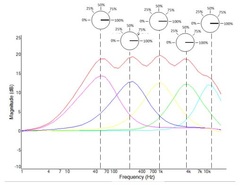
The Class D Amplifier
Class D amplification is a very interesting process. Class D is very different from most classic amplifiers because its has a drastically different technical process. The biggest benefit of the Class D style amplifier is that it's theoretical power efficiency is 100%.
The Class D amplifier basically takes an input signal wave, converts it into a digital wave, and uses two power MOSFETs to boost the boolean voltages that the digital signal is at. These MOSFETs are used at switches. The MOSFETs as switches do not need to be biased, so there is no power loss in biasing the transistors (unlike most classical amplifiers). Because the Class D amplifier is so power efficient, it is easy to make a very loud amplifier in a very small package.
Class D amplification is a very interesting process. Class D is very different from most classic amplifiers because its has a drastically different technical process. The biggest benefit of the Class D style amplifier is that it's theoretical power efficiency is 100%.
The Class D amplifier basically takes an input signal wave, converts it into a digital wave, and uses two power MOSFETs to boost the boolean voltages that the digital signal is at. These MOSFETs are used at switches. The MOSFETs as switches do not need to be biased, so there is no power loss in biasing the transistors (unlike most classical amplifiers). Because the Class D amplifier is so power efficient, it is easy to make a very loud amplifier in a very small package.

The Equalizer
The equalizer uses different filters to change the sound coming out of the amplifier. Separate filters control how much amplification a specific band receives. The 5-band filter used in this project can control the loudness of the lows, middle-lows, middle, middle-high, and high frequency bands. This customization allows the user to get different sounds out of the amplifier system.
The equalizer uses different filters to change the sound coming out of the amplifier. Separate filters control how much amplification a specific band receives. The 5-band filter used in this project can control the loudness of the lows, middle-lows, middle, middle-high, and high frequency bands. This customization allows the user to get different sounds out of the amplifier system.